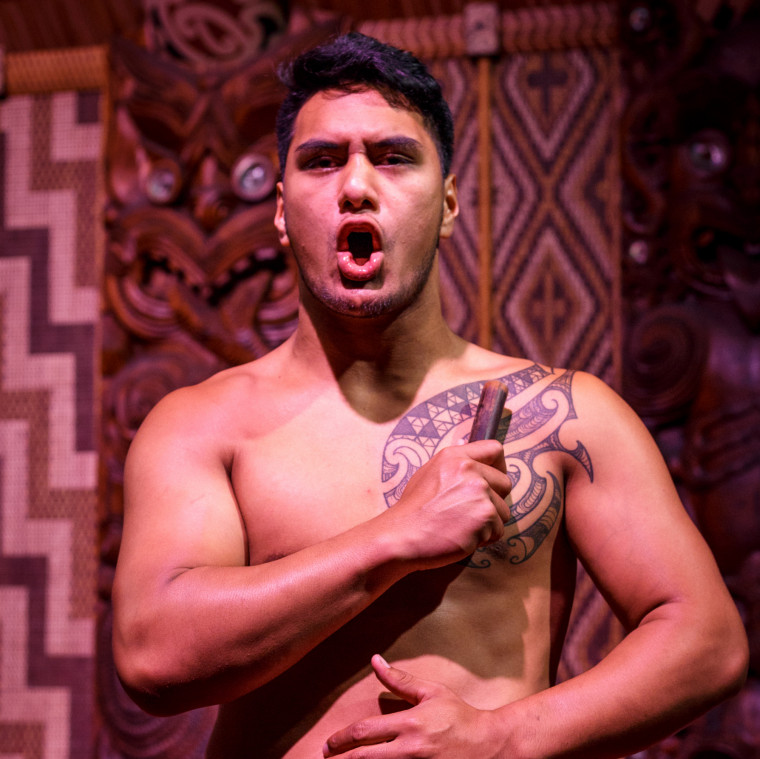Overseas and Off-Campus Programs Blog
Te Reo with Ev!
Open gallery

Author Name
Author Program
Program Semester and Year
Our first field trip was rich with cultural learning experiences , during which we traveled to Waitangi treaty grounds, to the Whakapapa (pronounced “fa-ka-pa-pa”) visitor centre, to the Tongariro Crossing, and many other places of cultural significance. Along the way, we were lucky enough to have a wonderful professor called Everard accompany us as our cultural liaison. He really helped enrich the cultural experiences of our initial adventures.
While hiking the Tongariro crossing on January 14th, he recalled the popular cultural myth that explained the positioning of the very mountains (Pihanga, Tongariro, Ngauruhoe, Ruapehu, and Taranaki) that we were hiking through: several mountains were in love with Pihanga, and competed for her love. Taranaki lost the worst, and thus was banished to the sea, and was forced to move within one day. He carved rivers that now lay between the other mountains and the sea, and North up the coast line until he stopped where he now stands.
On the day after the hike, we had our first lesson in Maori language (Te Reo) with Ev. Te Reo simply means “the language,” in Maori. We learned what consonants (h, k, m, n, p, r, t, w, ng, wh) and vowel sounds (a, e, i, o, u) existed in the language and how to pronounce them, as well as how to pronounce the diphthongs (ai, ao, au, ae) that also exist in te reo.
In addition to learning pronunciation, we learned how to introduce ourselves. A personal introduction is called a Mihi. In so far as what I have learned about delivering a Mihi, I understand that it is comprised of several introduction elements that are always delivered in the same order. You begin by explaining your waka (the canoe that delivered your ancestors onto New Zealand), your maunga (your mountain), your awa (river), your iwi (tribe), your hapu (sub tribe), and your marae (your meeting house). As non-Maoris, our Mihis would not utilize all these elements that are traditional, but it’s still important and respectful to deliver our Mihis in Maori when introducing ourselves on a marae. We did not learn how to present our entire Mihi, but we did learn how to give a very, very, very shortened version of it. Mine goes like this:
Kia ora
Ko Catherine au
No America au
No reira, kiaora koutou
The last line means: Therefore, good morning to you all.
It is easy to see how the mihi incorporates fundamental Maori beliefs pertaining to identity. In most conversations I’ve ever had, saying my name has been the first thing I’ve said. But, as Ev explained, in Maori culture, people care more about creating connections between shared pasts. That’s why you begin with your Waka, Iwi, Hapau… all leading up to the present, up to you. I can especially see how these types of introductions are relevant when you present yourself on a Marae.
Lastly, Ev taught us and had us practice the hongi. The origin of a hongi comes from a myth of the creation of the first person Hineahuone – formed by clay by the god Tane, who then shared his breath with her and breathed life into her. People in NZ practice it as a greeting by pressing noses and foreheads gently against each other, shaking hands, and symbolically sharing breath.
We’re looking forward to our visit to the marae, where we will be able to (hopefully) be able to give our mihis and utilize some of the conversational maori we’ve learned so far!
Sincerely yours,
Cate
Overseas and Off-Campus Programs is located in room 206 of Albany Quadrangle on the Undergraduate Campus.
MSC: 11
email overseas@lclark.edu
voice 503-768-7295
fax 503-768-7300
Director Blythe Knott
Overseas and Off-Campus Programs
Lewis & Clark
615 S. Palatine Hill Road MSC 11
Portland OR 97219